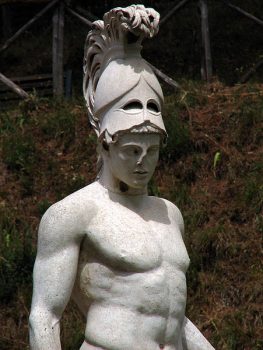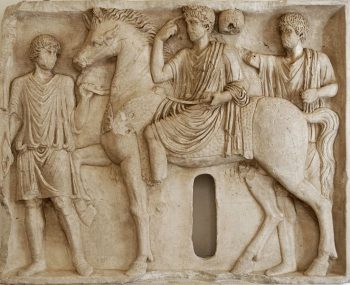The New Years in March Posted by Brittany Britanniae on Jan 4, 2017 in Uncategorized
Salvete Omnes! I hope everyone’s New Years passed with cheer and hope! I hope 2017 calls in more happiness and joy for us all..
The Ancient Romans, before 153 B.C.E. and Julius Caesar’s changes, used to celebrate the new year in what we consider early March. This was a very ancient tradition. The very first New Years celebrations known to us in records were practiced by the Mesopotamian thousands of years beforehand. This is because the New Year used to be associated with the vernal equinox instead of the winter solstice. It may have something to do with the longer days and the more concentrated sunlight that seemed more appropriate to beckon in the New Year, but, today, we celebrate the Sun’s victory in coming back up from hanging so low in the sky after the solstice. But let us look back to when this decision was made and what the traditions were before this change. After all, if Caesar had preferred to keep New Years in March, the entire world might right now still be in 2016….
Mensis Martius 1 (Kalends) – Kalendae Martiae
March was the first month before the change, but the inclusion of January and February pushed it down to being the third month, as we know it today. The first day of the month of March used to be the first day of the year before 153 B.C.E. The beginning of March was the time when the citizens of the empire could return to an active life. After the winter, they could go back to farming, military campaigning, and sailing. Farmers would begin to trellis vines, prune plants, and sow spring wheat during this transition. The changing of the weather and seasons made the beginning of March a very convenient time for new beginnings. The Menologia Rustica, the Farmer’s Almanac, tells farmers that the days will become more even as they can expect 12 hours of sunlight and 12 hours of night. This is due to the vernal equinox which was official observed on March 25th for the Ancient Romans. For us, today, we observe March 21st as the equinox.
Because of the significance of the start of March there were multiple events that were being celebrated at the same time.
Feriae Marti
As the sacred fire of Rome was renewed at the start of March the priesthood of the Salii had their own celebrations. The priests are known as “the leaping priests” due to their shows of jumping and leaping. Their order was dedicated to Mars and so the beginning of the month that was the namesake of their patron god was an auspicious time. These priests would have a procession through Rome as they sing the Carmen Saliare. The fragments of the chant of the Carmen Saliare that have survived are difficult for anyone to decipher. Even Cicero found it difficult to make much sense out of the verses:
Original Text
divum +empta+ cante, divum deo supplicate
cume tonas, Leucesie, prae tet tremonti
+quot+ ibet etinei de is cum tonarem
…cozeulodorieso.
Omnia vero adpatula coemisse.
Ian cusianes duonus ceruses dunus Ianusve
vet pom melios eum recum.
Approximate Translation:
Sing of him, the father of the gods! Appeal to the God of gods!
When thou thunderest, O God of light, they tremble before thee!
All gods beneath thee have heard thee thunder!
…
but to have acquired all that is spread out
Now the good … of Ceres … or Janus
…
This procession has been interpreted differently by different historians. Some say that the procession is a ritual to protect the empire’s armies, other say that it was done to signify the reopening of the warring seasons and others say that it was a ritual for the expulsion of the last year – since it is so close to the new year. The priests were also probably observing the fact that is was also Mars’ birthday (dies natalis).
Matronalia (or Matronales Feriae)
Another celebration that took place at the beginning of March was the Matronalia. This was a festival celebrating Juno Lucina, the goddess of childbirth. Befitting a time of new beginnings the Ancient Romans also took this time to show respect to mothers and the act of childbirth.
On this day, women could participate in rituals at the temple where offerings were presented at the temple dedicated to Juno Lucina on the Esquiline Hill (ca. 286 B.C.E.). The records of what women were allowed or expected to do are fragmented, but it is known that women were to wear their hair loosely when the usual Roman decorum was to wear it up. Women were to also wear their clothing in a loose way, forgoing any belts or knots on their robes.
When women returned home they were presented with gifts from their husbands and daughters, no mention of a son’s duty on this day. Husbands were to offer prayers in their wives’ favors. And as the Roman men had been expected to cook a meal for the slaves on Saturnalia, women were expected to cook for their slaves on Matronalia and were to give them the day off, as well.
Ancient Rome was full of so many rich and profound cultural observances. Some of these have been left behind in history. Although it is common that we see our own traditions are echoes of traditions started by these ancient people, we can also see that things have changed. We have just concluded out celebrations for the New Year, but nearly 2000 years ago the Romans would consider the year not yet over. However, the same sentiments remains.

Build vocabulary, practice pronunciation, and more with Transparent Language Online. Available anytime, anywhere, on any device.





